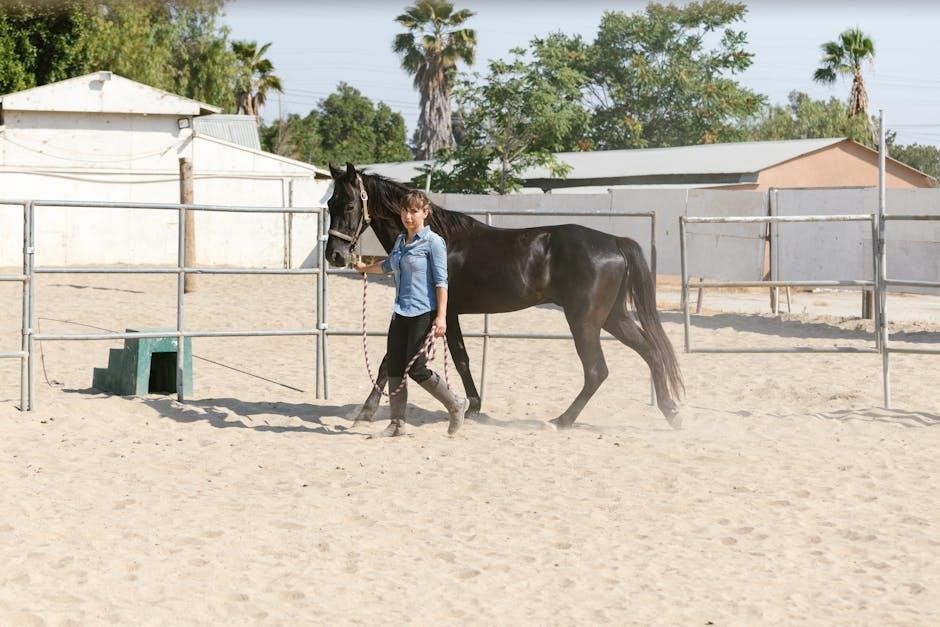
horse bits guide
Horse bits are essential tools for communication and control between a horse and rider. They play a crucial role in training, guidance, and ensuring a harmonious partnership. With various designs, materials, and purposes, bits are tailored to suit different horses, disciplines, and rider needs. This guide provides a comprehensive overview to help you understand the basics of horse bits and make informed decisions for your equine companion.
1.1 What Are Horse Bits?
A horse bit is a metal piece placed inside the horse’s mouth, connected to reins, allowing riders to communicate and guide the horse. As part of the bridle, bits apply pressure to sensitive areas like the tongue, bars, and lips, helping riders control direction and speed. They are essential for clear communication and effective training, ensuring harmony between horse and rider during various equestrian activities.
1.2 Importance of Bits in Horse Riding
Horse bits are vital for establishing clear communication between the rider and the horse. They facilitate precise control, enabling riders to guide the horse effectively. A well-chosen bit enhances responsiveness, comfort, and trust, making training and performance smoother. Proper use of bits ensures a balanced partnership, allowing horses to understand cues accurately, which is essential for achieving desired behavior and optimal performance in various equestrian disciplines. A bit’s role is both functional and fundamental to the riding experience.
History and Evolution of Horse Bits
Horse bits have evolved over thousands of years, from ancient civilizations to modern designs. Early bits were simple, while advancements in materials and design have improved functionality and horse comfort.
2.1 Ancient Civilizations and Early Bits
Ancient civilizations, such as the Egyptians, Greeks, and Assyrians, were among the first to use horse bits, with early designs often made of bronze or bone. These bits were simple, typically consisting of a basic bar or ring system to guide horses. The purpose was primarily for control, with little emphasis on comfort. As horse domestication advanced, so did bit designs, reflecting the growing understanding of horse behavior and the need for more refined communication tools;
2.2 Development Through the Middle Ages
During the Middle Ages, horse bits evolved significantly, influenced by the rise of cavalry and knightly warfare. Bits became more sophisticated, with the introduction of curb bits that utilized leverage for greater control. Iron became the primary material, offering durability and strength. The design often included intricate details, reflecting the craftsmanship of the time. Regional variations emerged, with different cultures adapting bits to suit their specific needs and riding styles, laying the groundwork for the diverse range of bits seen today.
2.3 Modern Advances in Bit Design
Modern bit design has focused on enhancing horse comfort and performance. Innovations include ergonomic shapes, adjustable features, and materials like copper and sweet iron, which promote salivation and acceptance. The development of mullen mouth and gag bits offers specific solutions for training and behavioral needs. Advances in metallurgy have improved durability, while designs cater to various disciplines, ensuring a tailored approach for optimal communication between horse and rider. These innovations reflect a deeper understanding of equine anatomy and behavioral responses to bitting systems.

How Horse Bits Work
Horse bits function by applying pressure to the bars, tongue, and lips, using leverage and the rider’s hands to guide the horse’s movement precisely for effective communication.
3.1 Points of Contact in the Horse’s Mouth
The bit primarily contacts the bars, tongue, and lips of the horse’s mouth; The bars are the bony areas behind the front teeth, while the tongue and lips also feel pressure. Proper fitting ensures comfort and effectiveness, avoiding discomfort or pain. The bit’s design and material influence how these points of contact work to communicate cues from the rider to the horse, ensuring clear and precise communication during training and riding activities.
3.2 Types of Leverage and Pressure Points
Horse bits utilize leverage and pressure points to communicate cues from rider to horse. Types of leverage include direct, where reins apply pressure directly, and indirect, using shanks to amplify force. Pressure points are areas in the horse’s mouth, such as the bars, tongue, and lips. Bit design influences these points: curb bits affect the poll and chin, while snaffles focus on the bars. Understanding leverage and pressure is key to selecting the right bit for comfort and effectiveness.
3.3 The Role of the Rider’s Hands
The rider’s hands play a vital role in guiding the horse through subtle cues transmitted via the reins and bit. Skilled hands ensure clear communication, using gentle yet firm pressure to convey intent. The hands must be soft yet precise, avoiding harsh movements that could cause discomfort or confusion. Proper hand positioning and sensitivity are essential to maintain a harmonious connection, allowing the horse to respond willingly to aids. This physical and mental link fosters trust and responsiveness, making the rider’s hands a cornerstone of effective communication.
Materials Used in Horse Bits
Horse bits are crafted from various materials, including stainless steel, copper, and sweet iron, each offering unique benefits like durability, salivation promotion, or gentle rusting for horse comfort.
4.1 Stainless Steel Bits
Stainless steel bits are highly durable and resistant to corrosion, making them a popular choice for horse riders. They are easy to clean and maintain, ensuring hygiene and longevity. Unlike other materials, stainless steel bits do not rust, which means they remain smooth and comfortable for the horse’s mouth over time. Their neutral taste does not react with the horse’s saliva, providing a consistent and reliable performance. This makes them ideal for horses of all ages and training levels.
4.2 Copper and Sweet Iron Bits
Copper and sweet iron bits are favored for their gentle, stimulating effects on a horse’s mouth. Copper bits promote salivation, encouraging a softer mouth and better acceptance of the bit. Sweet iron bits are made from cold-rolled steel with a sweet iron mouthpiece that oxidizes over time, creating a pleasant taste horses find appealing. Both materials are less harsh than stainless steel, making them ideal for sensitive horses or those in early training. They encourage calmness and responsiveness, enhancing the horse-rider connection.
4.4 Other Materials and Their Effects
Besides stainless steel, copper, and sweet iron, bits can be made from rubber, plastic, or titanium. Rubber bits are soft and gentle, ideal for young or sensitive horses to prevent mouth soreness. Plastic bits are lightweight and warm quickly, offering comfort but requiring regular inspection for wear. Titanium bits are hypoallergenic, durable, and lightweight, suitable for horses with metal sensitivities. Each material offers unique benefits, catering to different horse needs and preferences, ensuring comfort and effectiveness in communication.

Types of Horse Bits
Horse bits vary widely, including snaffle, curb, pelham, gag, and mullen mouth bits. Each type serves specific purposes, ranging from gentle training to precise control, catering to different disciplines and horse needs.
5.1 Snaffle Bits
Snaffle bits are the most common type, featuring a simple design with a jointed mouthpiece. They apply pressure to the horse’s bars, tongue, and lips, offering clear communication. Ideal for young or inexperienced horses, snaffles are gentle yet effective for basic training. Available in various materials like stainless steel, copper, or sweet iron, they promote salivation and acceptance. Snaffle bits are versatile, suitable for multiple disciplines, making them a popular choice among riders seeking a balanced and humane training tool.
5.2 Curb Bits
Curb bits are designed for advanced training and offer a higher level of control. They feature a longer cheekpiece and a curb chain, creating leverage that applies pressure to the horse’s poll, chin groove, and bars. This design is ideal for horses that require precise guidance. Curb bits are typically used in combination with a bridoon in double bridles or alone in specific disciplines. Proper fitting and use are crucial to ensure comfort and effectiveness, as they can be more intense than snaffle bits.
5.3 Pelham Bits
Pelham bits combine elements of snaffle and curb bits, offering dual action for horses that need both communication and control. They feature a single mouthpiece and two rings, allowing riders to use either a single or double rein. The Pelham bit applies pressure to the bars, tongue, and poll, with the option for leverage when needed. This versatility makes them suitable for horses transitioning between bits or requiring clear guidance. They are widely used in various equestrian disciplines and are known for their balanced effect.
5.4 Gag Bits
Gag bits are designed for strong or spirited horses that require additional control; They feature a sliding mouthpiece that, when reins are applied, exerts pressure on the horse’s mouth, bars, and poll. This action encourages the horse to lower its head and respond to cues. Gag bits are often used in disciplines like show jumping or eventing where precise control is essential. However, they should be used sparingly and with caution, as they can be harsh if not applied correctly by an experienced rider.
5.5 Mullen Mouth Bits
Mullen Mouth Bits feature a straight, unjointed mouthpiece that applies even pressure across the horse’s tongue, bars, and lips. This design is gentle and ideal for sensitive horses or those that dislike jointed bits. Made from soft materials like copper or sweet iron, they encourage salivation and comfort. Mullen Mouth Bits are often used for young or green horses, as they provide clear communication without pinching. They are a popular choice for horses that lean on the bit, offering a mild yet effective aid for training and riding.

Choosing the Right Bit
Selecting the right bit involves considering the horse’s age, training level, and specific needs. It ensures comfort, clear communication, and effectiveness for both horse and rider.
6.1 Factors Influencing Bit Selection
Several factors influence the selection of a horse bit, including the horse’s age, breed, and training level. The rider’s experience and the specific equestrian discipline also play a role. Additionally, the horse’s mouth anatomy, sensitivity, and any behavioral issues must be considered. The material and design of the bit, such as jointed or straight, can affect comfort and effectiveness. Understanding these factors ensures the bit is both functional and comfortable, promoting a positive riding experience for both the horse and rider.
6.2 Matching the Bit to the Horse’s Age and Training
The horse’s age and training level significantly influence bit selection. Young or inexperienced horses often benefit from milder bits, such as snaffle bits, to avoid overwhelming them. As horses mature and advance in training, bits with more specific functions may be introduced. The bit should align with the horse’s ability to respond to cues and its overall comfort. Proper matching ensures effective communication and supports the horse’s developmental stages, fostering a positive and progressive training environment.
6.3 Specific Needs and Disciplines
Choosing the right bit also depends on the horse’s specific needs and the discipline being practiced. For instance, dressage often uses double bridles for precision, while jumping may prefer milder snaffle bits. Western disciplines might opt for curb bits for enhanced control. Each bit type is designed to meet the unique demands of the activity, ensuring clarity in communication and suitability for the horse’s role. Matching the bit to the discipline ensures optimal performance and comfort for the horse.

Sizing and Fitting the Bit
Proper sizing and fitting are crucial for the horse’s comfort and effectiveness of communication. Measure the mouth to ensure the bit sits correctly, avoiding pressure points or discomfort.
7.1 Measuring the Horse’s Mouth
Measuring the horse’s mouth is essential to ensure proper fit. Use a bit gauge or a marked bit to determine the correct size. Insert the bit gently, ensuring it rests comfortably without pinching or excessive space. The bit should sit snugly, allowing about 1/4 inch of space on each side; Proper measurement prevents discomfort and ensures effective communication. Always consider the horse’s age, breed, and mouth structure for an accurate fit.
7.2 Adjusting the Bit for Proper Fit
After measuring, adjust the bit to ensure it sits correctly in the horse’s mouth. The bit should be snug but not overly tight, allowing for about 1/4 inch of space on each side. Check the alignment with the horse’s mouth contours and ensure the bit is not rotated. Proper adjustment ensures comfort and effective communication. If unsure, consult a professional to achieve the perfect fit, as an ill-fitting bit can cause discomfort or performance issues;
7.3 Common Fitting Mistakes to Avoid
Common mistakes include using a bit that is too tight or too loose, causing discomfort or lack of control. Misalignment with the horse’s mouth contours can lead to uneven pressure. Over-tightening the cheek pieces may restrict movement, while excessive slack can reduce effectiveness. Regularly inspect the bit’s position and fit to prevent issues like pinched cheeks or tongue discomfort. Proper fitting ensures the horse’s comfort and responsiveness, avoiding behavioral problems or poor performance.

The Role of Bits in Training
Horse bits are vital for clear communication, setting boundaries, and reinforcing commands. They help establish trust and responsiveness, aiding in behavioral correction and refining the horse’s performance during training.
8.1 Communication Between Horse and Rider
Effective communication between horse and rider relies heavily on the bit. It serves as a bridge, translating subtle rein pressure into clear signals. A well-chosen bit ensures the horse understands cues without discomfort, fostering trust. Proper use of the bit allows riders to convey commands precisely, while the horse learns to respond willingly. This mutual understanding is key to successful training and a harmonious partnership, making the bit an indispensable tool in equine communication.
8.2 Aids in Training and Behavioral Correction
Horse bits are vital tools for addressing behavioral issues and aiding in training. By applying targeted pressure, bits help refine a horse’s responses to cues, correcting unwanted habits. Different bit designs allow riders to focus on specific areas, such as discouraging pulling or promoting proper head carriage. When used correctly, bits enhance clarity in communication, helping horses understand expectations and respond appropriately. This makes bits indispensable for shaping behavior and improving overall performance in a structured, effective manner.
8.3 Building Trust and Responsiveness
A well-chosen and properly used horse bit fosters trust and responsiveness between the horse and rider. By providing clear and consistent communication, bits help horses understand cues, building a foundation of mutual respect. Gentle pressure and precise signals encourage horses to respond willingly, strengthening the bond. Over time, this clear communication enhances the horse’s confidence and willingness to obey, creating a partnership rooted in trust and understanding. Proper bit use is essential for developing a responsive and reliable equine companion.

Impact of Bits on Horse Performance
Horse bits significantly impact performance by affecting comfort, willingness, and responsiveness. Properly fitted bits enhance control and precision, while poorly chosen ones may cause resistance or discomfort, hindering effectiveness.
9.1 Effects on Comfort and Willingness
A well-fitted bit ensures the horse’s comfort, preventing pain or discomfort in the mouth, which can lead to resistance or unwillingness to respond. A bit that is too tight or too loose can cause pressure points, affecting the horse’s ability to perform effectively. Materials like copper or sweet iron promote salivation and relaxation, while harsh or poorly designed bits may lead to tension. Comfort directly influences a horse’s willingness to obey cues, making bit selection and fit critical for optimal performance.
9.2 Enhancing Control and Precision
A properly designed and fitted bit enhances control by providing clear communication between the rider and the horse. The bit translates the rider’s commands into specific pressures, allowing for precise guidance. Different bit types, such as snaffles or curbs, offer varying levels of leverage to refine movements. A well-chosen bit ensures the horse responds accurately to aids, enabling sharper turns, smoother transitions, and more nuanced performance. This clarity of communication is essential for achieving precision in any equestrian discipline.
9.3 Addressing Performance Issues
The right bit can help resolve performance issues by improving communication and comfort. Bits with specific pressure points, such as snaffles or curbs, can address problems like heaviness or lack of responsiveness. Materials like copper or sweet iron may enhance acceptance, reducing resistance. Proper fitting ensures the bit functions as intended, preventing discomfort that hinders performance. By matching the bit to the horse’s needs, riders can address behavioral challenges and improve overall responsiveness, fostering a more effective partnership between horse and rider.

Common Misconceptions About Bits
Many riders mistakenly believe harsh bits are more effective, but bit effectiveness depends on proper fit, material suitability, and clear communication, not just severity or design alone.
10.1 Myths vs. Reality
A common myth is that harsher bits are more effective, but reality shows that gentle, well-fitted bits promote better communication. Many believe certain materials or designs guarantee improved behavior, yet effectiveness depends on the horse’s needs and rider skill. Another myth is that specific bits suit all horses, while reality highlights the importance of customization. Understanding these misconceptions helps riders choose bits that enhance comfort and performance rather than relying on unproven assumptions.
10.2 Understanding Bit effectiveness
10.2 Understanding Bit Effectiveness
Bit effectiveness hinges on proper fit, material, and design, as these factors influence a horse’s comfort and responsiveness. A well-chosen bit encourages clear communication, while a poorly fitted one can cause resistance or discomfort. Riders must consider their horse’s age, training level, and specific needs to select a bit that enhances performance. Regular assessment ensures the bit remains suitable, adapting as the horse grows or training progresses. Collaboration with professionals can further optimize bit effectiveness, ensuring a positive experience for both horse and rider.
10.3 Debunking Popular Myths
Several myths surround horse bits, such as the belief that harsher bits are more effective or that all bits are inherently cruel. In reality, effectiveness depends on proper fit, material, and usage. A bit’s severity is not solely determined by its design but by how it is employed. Modern bits prioritize horse comfort, with features like ergonomic shapes and gentle pressure distribution. Understanding these truths helps riders make informed decisions, ensuring both the horse’s well-being and optimal communication during training and performance.
Maintenance and Care of Bits
Regular cleaning and sanitizing of bits prevent bacteria and odor, ensuring hygiene. Inspect bits for wear and tear to maintain effectiveness and safety. Proper storage keeps bits in good condition, preventing damage and prolonging lifespan.
11.1 Cleaning and Sanitizing
Regularly clean and sanitize horse bits to maintain hygiene and prevent bacterial growth. Use mild soap and warm water to scrub all surfaces, paying attention to crevices where debris accumulates. Rinse thoroughly to remove any residue. For metal bits, avoid harsh chemicals that may cause corrosion. Sanitize with a vinegar solution to ensure cleanliness. Dry bits completely before storage to prevent rust or mold. Regular cleaning ensures optimal performance and comfort for the horse.
11.2 Storage and Maintenance Tips
Store horse bits in a clean, dry environment to prevent rust and corrosion. For metal bits, use a soft cloth to wipe down and apply a small amount of oil to maintain their condition. Regularly inspect for wear and tear, replacing any damaged parts. Avoid stacking bits to prevent scratching. Proper storage and maintenance ensure longevity, functionality, and safety for both the horse and rider. Regular polishing can also help maintain the bit’s appearance and performance over time.
11.4 Regular Inspection for Wear
Regularly inspect horse bits for signs of wear, such as corrosion, cracks, or sharp edges. Check for smoothness and ensure no parts are loose or damaged. Worn bits can cause discomfort or injury to the horse, leading to behavioral issues. Inspect metal bits for rust and replace any damaged components promptly. For non-metallic bits, look for fractures or excessive wear. Proper inspection ensures the bit remains safe and effective, maintaining clear communication between horse and rider. Replace worn or damaged bits immediately to prevent harm.
Troubleshooting Bit Issues
Identify common bit issues like improper fit, excessive wear, or discomfort. Address problems by adjusting the bit or consulting a professional to ensure optimal performance and horse comfort.
12.1 Identifying Common Problems
12.2 Adjustments and Solutions
To address common bit-related issues, start by ensuring proper fit and alignment. Adjusting the bit to sit correctly in the horse’s mouth can alleviate discomfort. Replacing worn or damaged bits is essential to prevent uneven pressure. Introducing a softer or differently designed bit may resolve resistance. Consulting a professional, such as a trainer or equine dentist, can provide tailored solutions. Regular bit maintenance and horse dental checks are key to preventing recurring problems and ensuring optimal comfort and performance for the horse.
12.3 When to Consult a Professional
Consult a professional if your horse shows persistent discomfort, resistance, or behavioral issues related to the bit. Trainers, equine dentists, or bit fitters can assess the situation and recommend solutions. If you’re unsure about proper fitting, materials, or design, seek expert advice. Regular check-ups with professionals ensure the horse’s comfort and optimal performance, addressing issues before they escalate.